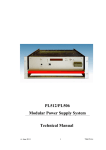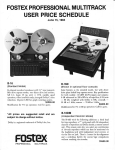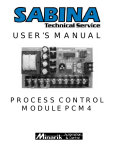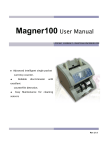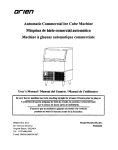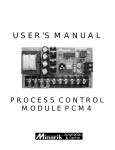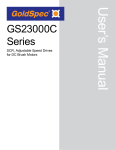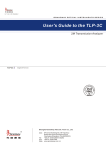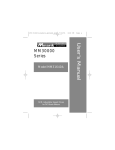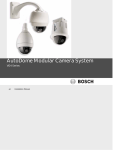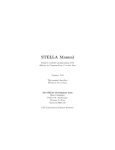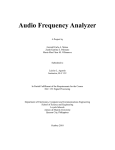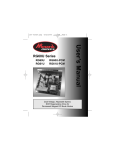Download User Manual - Applied Industrial Technologies
Transcript
PROCESS CONTROL MODULE GS4 User’s Manual GS4 Contents Safety Warnings Safety Warnings . . . . . . . . . . . . . . . . . . . . . . . . . . . . . . . . . . . . 2 Specifications . . . . . . . . . . . . . . . . . . . . . . . . . . . . . . . . . . . . . . 3 SHOCK HAZARD AVOID HEAT KEEP DRY Dimensions . . . . . . . . . . . . . . . . . . . . . . . . . . . . . . . . . . . . . . . . 3 AVOID VIBRATION Introduction . . . . . . . . . . . . . . . . . . . . . . . . . . . . . . . . . . . . . . . . 3 Installation . . . . . . . . . . . . . . . . . . . . . . . . . . . . . . . . . . . . . . . . . 4 • This symbol denotes an important safety tip or warning. Please read these instructions carefully before performing any of the procedures contained in this manual. • DO NOT INSTALL, REMOVE, OR REWIRE THIS EQUIPMENT WITH POWER APPLIED. Have a qualified electrical technician install, adjust and service this equipment. Follow the National Electrical Code and all other applicable electrical and safety codes, including the provisions of the Occupational Safety and Health Act (OSHA), when installing equipment. • Reduce the chance of an electrical fire, shock, or explosion by proper grounding, over-current protection, thermal protection, and enclosure. Follow sound maintenance procedures. Mounting . . . . . . . . . . . . . . . . . . . . . . . . . . . . . . . . . . . . . . . . . 4 Wiring . . . . . . . . . . . . . . . . . . . . . . . . . . . . . . . . . . . . . . . . . . . 4 Shielding guidelines . . . . . . . . . . . . . . . . . . . . . . . . . . . . . . . 4 Screw terminal block . . . . . . . . . . . . . . . . . . . . . . . . . . . . . . . . 4 Connections . . . . . . . . . . . . . . . . . . . . . . . . . . . . . . . . . . . . . . . 5 AC line connections . . . . . . . . . . . . . . . . . . . . . . . . . . . . . . . 5 Input signal connections . . . . . . . . . . . . . . . . . . . . . . . . . . . . 6 Master signal generator . . . . . . . . . . . . . . . . . . . . . . . . . . . . 5, 6 Output voltage connections . . . . . . . . . . . . . . . . . . . . . . . . . . . 7 Multiple follower requirements . . . . . . . . . . . . . . . . . . . . . . . . . 7 Multiple drives following a single signal input . . . . . . . . . . . . 7 Master GS4 with multiple drives following . . . . . . . . . . . . . . 7 Calibration . . . . . . . . . . . . . . . . . . . . . . . . . . . . . . . . . . . . . . . . . 8 Signal Input Adjust . . . . . . . . . . . . . . . . . . . . . . . . . . . . . . . . 8 WARNING Circuit potentials are at 120 VAC or 240 VAC above earth ground. Avoid direct contact with the printed circuit board or with circuit elements to prevent the risk of serious injury or fatality. Use a non-metallic screwdriver for adjusting the calibration trimpots. Use approved personal protective equipment and insulated tools if working on this drive with power applied. DIP switches . . . . . . . . . . . . . . . . . . . . . . . . . . . . . . . . . . . . . 8 Input signal calibration . . . . . . . . . . . . . . . . . . . . . . . . . . . . . 8 Input voltage calibration . . . . . . . . . . . . . . . . . . . . . . . . . . . . 9 Input current calibration . . . . . . . . . . . . . . . . . . . . . . . . . . . . 9 Troubleshooting . . . . . . . . . . . . . . . . . . . . . . . . . . . . . . . . . . . . 9 Before troubleshooting . . . . . . . . . . . . . . . . . . . . . . . . . . . . . 9 Illustrations Figure 1. Process Control Module (GS4) Dimensions . . . . . . . . 3 Figure 2. Screw Terminal Block. . . . . . . . . . . . . . . . . . . . . . . . . . 4 Figure 3. 115 VAC Power Connection. . . . . . . . . . . . . . . . . . . . . 5 Figure 4. 230 VAC Power Connection. . . . . . . . . . . . . . . . . . . . . 5 Figure 5. Connection – Following an External Signal. . . . . . . . . 5 Figure 6. Unidirectional Manual Master Signal Source Connection . . . . . . . . . . . . . . . . . . . . . . . . . . . . 6 Figure 7. Bidirectional Manual Master Signal Source Connection . . . . . . . . . . . . . . . . . . . . . . . . . . . . 6 Figure 8. Connection – Output Voltage. . . . . . . . . . . . . . . . . . . . 6 Figure 9. Connection – Multiple Follower System. . . . . . . . . . . . 7 Figure 10. Signal Input Adjust. . . . . . . . . . . . . . . . . . . . . . . . . . . 7 Figure 11. Connection – Ratio Potentiometers Multiple Follower System. . . . . . . . . . . . . . . . . . . . . . . . . . . . . . . . . . . . 7 Figure 12. SIGNAL INPUT ADJ - Calibration Positions. . . . . . . . 8 Figure 13. DIP Switch Settings. . . . . . . . . . . . . . . . . . . . . . . . . . 8 2 GoldSpec™ User’s Manual 2 Specifications Dimensions Dimensions Power Requirements IC501 C502 Input Signal Ranges (input circuit is isolated) C507 IC502 1.93 [49] IC503 SIGNAL INPUT ADJ INP P502 P503 TB502 1 2 3 –25 to +25 VDC –250 to +250 VDC 1–5 mADC, 4–20 mADC, 10–50 mADC C503 IC504 2.70 [69] SW501 1 P501 TB501 Input Impedance Voltage signal Current signal 1–5 mADC 4–20 mADC 10–50 mADC R R501 Voltage signal Narrow range Wide range Current signal C506 1 2 C501 C504 -1 5 +15 COM INPUT 1 6 7 8 INPUT 2 9 0-± 10VDC OUTPUT MODEL GCM4 GS4 120/240 VAC 2.1 WATTS T501 IC506 120/240 VAC, 50/60 Hz, single phase 1-5MA 4-20MA 10-50MA Line input 4.83 [123] C505 TP 10 >25K ohms 1K ohm 235 ohms 100 ohms 1.30 [33] Output Impedance Voltage range, max Linearity 0.35 [9] 800 ohms –10 to +10 VDC 4.22 [107] 4x 0.25 [6] STANDOFF USE #8 PANHEAD SCREWS 0.01% Operating Temperature Range 0 – 50 °C DIMENSIONS IN INCHES [MILLIMETERS] FigureALL 1. Process Control Module (GS4) Dimensions Model GS4 a grounded or(PCM4) floating,Dimensions bipolar, DC Figure 1. accepts Process Control Module signal input and generates a proportional isolated output voltage. The output of the GS4 follows the variations of its input: it increases as the signal increases and decreases as the signal decreases. This output can be supplied to the speed setting circuit of a motor drive to rotate the motor at a speed proportional to the signal input. Because the GS4 can follow bipolar input voltage signals, it can drive a regenerative variable speed drive through the complete range of motor speeds in both forward and reverse directions. This manual contains specifications, installation procedures, connections, and calibration procedures for the process control module, model GS4. Refer to your variable speed drive user’s manual for additional installation, operation, and troubleshooting procedures. GS4 3 Installation Shielding guidelines WARNING WARNING Do not install, rewire, or remove this control with input power applied. Doing so may cause fire or serious injury. Make sure you have read and understood the Safety Warnings before attempting installation. Mounting • GS4 components are sensitive to electrostatic fields. Avoid contact with the circuit board directly. • Protect the GS4 from dirt, moisture, and accidental contact. Provide sufficient room for access to the terminal block. • Mount the GS4 away from other heat sources. Operate within the specified ambient operating temperature range. The operating temperature range for the GS4 is 0°C 50°C.8:35 AM Page 22 0-0152r6.qxp through 3/30/2006 22 • Prevent loose connections by avoiding excessive vibration of the process control module board. Calibration Signal Input Adjust • Mount the GS4 in either a horizontal or vertical plane. • The GS4 is mounted using 4 – 0.25 inch [6mm] standoffs. See INPUT Figure ADJ 1, page 3 for the physical The SIGNAL potentiometer is used tolocations set the of these standoffs. Use #8 panhead screws to fasten maximum Test Point voltage to approximately 5 VDC, as the standoffs the mounting measured to between terminalssurface. TP and COM. The importance of this step is to scale the input signal voltage to keep it well within the range of the PCM4’s comparator chip. This calibration is only Wiring approximate. A tolerance of 0.2 Volts is acceptable. Under no circumstances should power and logic leads be bundled together. Induced voltage can cause unpredictable behavior any electronic device. As a general rule, manufacturer recommends shielding of all conductors. If it is not practical to shield power conductors, manufacturer recommends shielding all logic-level leads. If shielding of logic level leads is not practical, the user should twist all logic leads with themselves to minimize induced noise. It may be necessary to earth ground the shielded cable. Do not ground both ends of the shield. If the drive continues to pick up noise after grounding the shield, it may be necessary to add AC line filtering devices, or to mount the drive in a less noisy environment. Logic wires from other input devices, such as motion controllers and PLL velocity controllers, must be separated from power lines in the same manner as the logic I/O on the 7 Installation GS4. Screw terminal block Screw terminal block Connections to Minarik’s PCM4 are made to a screw terminal Connections the GoldSpec™’s GS4 areblock made to acounterscrew block. Using ato screwdriver, turn the terminal screw terminal block. Using a screwdriver, turn the terminal block clockwise to open the wire clamp. Insert stripped wire into the screw counterclockwise to open wire clamp. Insert wire clamp. Turn the terminal blockthe screw clockwise to clamp the stripped wire into the wire clamp. Turn the terminal block wire. See Figure 2. screw clockwise to clamp the wire. See Figure 2. The SIGNALWARNING INPUT ADJ is calibrated only when the PCM4 is following a voltage When the PCM4 is following a current with Do notsignal. install, remove, or rewire this equipment signal set the power SIGNAL INPUTFailure ADJ fully CW. See 12 may for applied. to heed thisFigure warning result in fire, explosion, or serious approximate calibration of SIGNAL INPUT ADJ. injury. Circuit potentials at 120 or 240 VAC above To calibrate the SIGNAL INPUTare ADJ: ground. To prevent the risk of injury or fatality, avoid direct contactvoltage with the printed circuit board or with 1. Apply the true maximum input. circuit elements. 2. Check at TPAWG vs. COM that it is approximately • voltage Use 18-24 wire to forverify signal wiring. Use 16-18 AWG 5V. Adjust SIGNAL INPUT ADJ if needed. wire for AC line (L1, L2) wiring. Figure Block Figure2.2.Screw ScrewTerminal Terminal Block 0 - 5 VDC 0 - 10 VDC 0 - 25 VDC 0 - 250 VDC Figure 12. SIGNAL INPUT ADJ - Calibration Positions 4 GoldSpec™ User’s Manual 10 Input signal connections Input signal connections Connections Connect theincoming incoming voltage or current signal Connect the voltage or current signal leadsleads to to INPUT 1 (terminal 8) and to COM (terminal the INPUT 1 (terminal 8) and to COM (terminal 7). If 7). theIfmaximum maximum input voltage will exceed 25V, connect the signal input voltage will exceed 25V, connect the signal leads to INPUT leads to INPUT 2 (terminal 9) and to COM (terminal 7). 2 (terminal 9) and to COM (terminal 7). See Figure 5 below. See Figure 5 below. Use insulated shielded or twisted pair Use insulated shielded wire or twisted pair wire for PCM4 input and for GS4 input and output signal leads longer than 18 inches. output signal leads longer than 18 inches. Connect the shielding Connect the shielding earthfrom ground at the and endtrim away to earth ground at the endtoaway the PCM4 the from the GS4 and trim the exposed shielding at the GS4 to exposed shielding at the PCM4 to preclude accidental grounding preclude accidental grounding of the GS4. of the PCM4. WARNING Do not connect this equipment with power applied. Failure to heed this directive may result in fire or serious injury. Manufacturer strongly recommends the installation of a master power switch in the voltage input line. The switch contacts should be rated at 2 amps AC and 250 volts Bundle thesignal-carrying signal-carrying leads separately the motor Bundle the leads separately fromfrom the motor leads leads or AC power leads. or AC power leads. Installation Installation Connect the AC power leads to terminals 1 and 4. SW501 SW501 P501 P501 C504 C504 1 1 4 4 AC POWER AC POWER 115 VAC 115 VAC P501 C504 9 9 +15 +15 COM COM INPUT 1 INPUT 1 5 5 6 6 7 7 8 8 AC POWER AC 230POWER VAC 230 VAC 8 9 R TP -15 +15 10 5 6 SIG (+) COM 7 COM (-) INPUT 1 8 TP 9 10 SIG (+) VOLTAGE SIGNAL RANGE 0 - ±250VDC Master signal generator -15 -15 4 4 7 INPUT 2 Figure 5. Connection––Following Following an Signal Figure 5. Connection anExternal External Signal 9 9 WARNING Bidirectional output mode should never be used with standard SCR (single quadrant) variable speed drives. These drives only respond to one polarity in their speed setting circuits. R 1 1 6 INPUT 1 CURRENT SIGNAL RANGES 1 - 5mA 4 - 20mA 10 - 50mA INPUT 2 INPUT 2 Figure 3. 115 VAC Power Connection TB501 TB501 5 R COM VOLTAGE SIGNAL RANGE 0 - ±25VDC R Figure3.3.115 115VAC VACPower Power Connection Figure Connection C504 C504 +15 COM (-) R -15 -15 -15 1 When operating on 120 VAC, leave the jumper bars installed between terminals 1 and 2 and between 3 and 4 (see Figure 3). This is how the unit is shipped from the factory. When operating on 230VAC, remove both jumper bars and place one jumper bar between terminals 2 and 3 (see Figure 4). 1 AC line connections TB501 TB501 Installation 5 5 +15 +15 6 6 COM COM 7 7 INPUT 1 INPUT 1 8 8 R INPUT 2 INPUT 2 The GS4 can be used as a master controller to: (1) provide a isolated DC master voltage input to other GS4 modules interfacing with standard variable speed drives or (2) to drive several variable speed drives directly, provided that their circuit design permits wiring of their speed circuits in common. 9 9 Unidirectional applications require a positive GS4 output. Connect a 10K ohm potentiometer (not provided with the GS4) as the master control pot using the +15 VDC supply on the GS4. Figure 4. 230 VAC Power Connection Figure 4. 230 VAC Power Connection Figure 4. 230 VAC Power Connection The normal wiring of an external master control potentiometer is the CW side of the potentiometer to +15 V supply (terminal 6), and the CCW side to COM (terminal 7). The potentiometer wiper is connected to INPUT 1 (terminal 8). See Figure 6 (page 6) . The potentiometer is rotated clockwise to increase the voltage at INPUT 1 and, therefore, increasing the GS4 output voltage. GS4 5 Installation (continued) Output voltage connections WARNING Bipolar input is necessary to control motor reversals when the motor is being driven by a four quadrant, regenerative variable speed drive. To wire the external master control potentiometer to provide a bipolar, adjustable voltage input signal, wire the potentiometer across the –15 and +15V supply terminals, with the CW end at +15V. Connect the pot wiper to the INPUT 1 (terminal 8). See Figure 7 (page 6). Always check the instruction manual supplied with the variable speed drive that will be interfaced with the GS4 module. The scheme shown for wiring to an external voltage source, as well as the specifications on that input, must be well understood before proceeding. Output connections are made to the small terminal block on the board (TB502). Connect the output leads to terminal 1 and 2 (Figure 8). When the input signal at INPUT1 is positive with respect to COM terminal 2 will be positive. The center position of the wiper produces zero input voltage. Potentiometer rotation CW from center produces The exception to this polarity rule occurs when the GS4 increasing positive voltage; CCW rotation from center 250-0152r6.qxp 3/30/2006 Page 16 follower. 13 Installation has been calibrated to8:35 bias its AM output as a voltage produces increasing negative voltage. An input of zero volts can be calibrated to produce a finite -15 +15 COM INPUT 1 INPUT 2 T C504 positive or negative output voltage. 5 10K OHM SPEED ADJUST POTENTIOMETER (NOT PROVIDED) 1 6 7 8 6 7 8 16 INPUT 2 9 1 9 1 CW Master Signal Source Connection Figure 6. Unidirectional Manual Master Signal Source -15 Connection +15 COM INPUT 1 INPUT 2 C504 Figure 6. Unidirectional Manual Master Signal Source Connection -15 C504 1 10K OHM SPEED ADJUST POTENTIOMETER (NOT PROVIDED) Figure 10K OHM SPEED ADJUST POTENTIOMETER 7.(NOT Bidirectional PROVIDED) T +15 COM INPUT 1 INPUT 2 XL/XLT PCM 4 Most GoldSpec™ SCR–type, non-regenerative drives SERIES DRIVE TB502 are designed with the speed setting voltage positive with 0 - +5 VDC OUTPUT respect to board common. The positive external signal S2 is brought to the “speed pot wiper” terminal, usually S1to the “speed designated S2, and the common signal lead pot CCW’ terminal usually S1. T 6 7 8 9 1 5 6 7 8 9 1 MM20000 GS23000C PCM GS44 TB502 T 5 - The GS4 output is a isolated DC voltage. It is brought into the speed setting circuit of a variable speed drive to replace Installation the main speed adjust potentiometer. 1 Figure 6. 10K OHM SPEED ADJUST POTENTIOMETER Unidirectional Manual (NOT PROVIDED) CW INPUT 1 2 5 COM 2 +15 0 - +2.8 VDC OUTPUT SERIES DRIVE S2 S1 Figure 8. Connection – Output Voltage Installation 17 RG51UA / MMRG PCM 4 + Manual Master Signal Source Connection TB502 2 -15 C504 13 1 Installation + 0 - ±10 VDC OUTPUT S2 S0 1 Figure 7. Bidirectional Manual Master Signal Source Connection PCM 4 TB502 2 Figure 7. Bidirectional Manual Master Signal Source Connection Series Drives RG300 / RG400 / RG500 Series Drives 0 - ±10 VDC OUTPUT S2 1 RB1 0 - ±10 VDC OUTPUT RG60 / MMRGD Series Drives S2 RB1 GoldSpec™ User’s Manual 1 6 2 PCM 4 TB502 ratioing pot to the input signal source potentiometer as shown in Figure 11 below. Master PCM4 with multiple drives following Multiple follower requirements If a GS4 is to provide the master input voltage signal as If a PCM4 to provide the master inputare voltage signal as detailed onispage 6, dedicated GS4’s again necessary. detailed 14must - 15, dedicated PCM4s are againon necessary. Each of on thepages GS4’s be modified as detailed page 19. Each of the PCM4s must bemay modified as detailed on page Ratioing potentiometers then be wired with their19. CW Ratioing potentiometers maymaster then beGS4 wired with their CW sides sides to terminal 2 of the and their CCW sidesto terminal 2 of1 the master PCM4 and their CCW sides to terminal 1 to terminal of the master GS4. of the master PCM4. WARNING Most GoldSpec™ variable speed drives cannot be wired with their speed-setting circuits in common with each other. They require a dedicated GS4 for each variable speed drive. Included are all GoldSpec™ models in the GS23000C series, and all regenerative drives (GS 6OU series). A multiple follower system using any of these drives must consist of a master GS4 driving follower GS4 modules. Installation + MASTER INPUT SIGNAL POTENTIOMETER 19 50K Multiple drives following a single signal input Multiple drives following a single signal input 50K - When more that one Minarik drive must follow one voltage When more than one GoldSpec™ drive must follow one signal, each must be wired individually to dedicated PCM4 voltage signal, each must be wired individually to dedicated modules. Each PCM4 module then receives the “master” input GS4 modules. Each GS4 module then receives the “master” signal. The MM30000 series discussed in the preceding input signal. paragraphs is the only exception. 7 10 PCM4 GS4 #1 7 10 PCM4 GS4 #2 7 10 PCM4 GS4 #3 Figure 11. Connection – Ratio Potentiometers Multiple Follower System Figure 11. Connection – Ratio Potentiometers Multiple Follower System Each of the GS4 units must first be modified. Each of the PCM4 units must first be modified. 1.Check that all 3 DIP switches (SW501) , located near the 1. Check that all 3 DIP switches (SW501) , located near the center of the board, are in their OFF position. center of the board, are in their OFF position. Calibration 2.Cut the left hand (CCW) pin of P501, the SIGNAL INPUT 2. ADJ, Cut the hand (CCW) of P501, theshows SIGNAL offleft each GS4. Thepin figure below thisINPUT trimmer ADJ, off each PCM4. The figure below shows this trimmer potentiometer. potentiometer. WARNING Dangerous voltages exist on the GS4 when it is powered. If the trimpots must be adjusted with power applied, use insulated tools and the appropriate personal protectionequipment. BE ALERT. High voltages can cause serious or fatal injury. SIGNAL INPUT ADJ CUT AND REMOVE LEFT PIN OF THE SIGNAL INPUT ADJ TRIMPOT ON EACH PCM4 BOARD 50K P501 Figure 10. Signal Input Adjust Figure 10. Signal Input Adjust Connect one 50K ohm ratioing potentiometer across the master input voltage signal for each dedicated GS4 module. Wire each ratioing pot to the input signal source potentiometer as shown in Figure 11 below. Master GS4 with multiple drives following GS4 7 As a general rule, 3/30/2006 Minarik recommends shielding 250-0152r6.qxp 8:35 AM Page of 22all Each DIP switch selects the range for input current following. DIP switch 1 is for 1 – 5 mA input, DIP switch 2 is for 4 – 20 mA input, and DIP switch 3 is for 10 – 50 mA input. input. To calibrate the SIGNAL INPUT ADJ: To calibrate the SIGNAL INPUT ADJ: 1.Apply the true maximum voltage input. 1. Apply the true maximum voltage input. 2.Check voltage at TP vs. COM to verify that it is 2. approximately Check voltage at5V. TPAdjust vs. COM to verify that it ADJ is approximately SIGNAL INPUT if needed. 5V. Adjust SIGNAL INPUT ADJ if needed. ON Installation 10 - 50 mA CURRENT SIGNAL INPUT 10 - 50 MA 10 - 50 MA 4 - 20 mA CURRENT SIGNAL INPUT 4 - 20 MA 10 - 50 MA 4 - 20 MA 10 - 50 MA SW501 SW501 SW501 1 - 5 MA Figure 13. DIP Switch Settings Input signal calibration Calibration of the MIN OUT and MAX OUT 15–turn trimpots is required to establish the relationship between the input voltage signal range and the output range. The true maximum and minimum input signal values are not required. Because the GS4 response is linear, any two calibration points define the output vs. input relationship. Select points as close to the range extremes as possible to minimize extrapolation error. The absolute maximum output from the GS4 is 10 VDC. The Figure 2. Screw Terminal Block minimum input voltage to the GS4 that can produce 10 VDC output is 5 VDC. 0 - 5 VDC 0 - 10 VDC 0 - 25 VDC 0 - 250 VDC Figure 12. SIGNAL INPUT ADJ - Calibration Positions Figure 12. SIGNAL INUT ADJ - Calibration Postiions Input voltage calibration To calibrate when using a voltage input signal: 1.Verify that all DIP switches are OFF. DIP switches 2.Set the SIGNAL INPUT ADJ to the input range position, as indicated on Figure 12, page 8. WARNING Only one DIP switch should be ON at a time and only when the GS4 is set up to follow a current signal. All three DIP switches must be OFF when following a voltage signal. 3.Apply the lower voltage input. 4.Set MIN OUT adjustment to obtain the desired lower Each DIP switch selects the range for input current following. DIP switch 1 is for 1 – 5 mA input, DIP switch 2 is for 4 – 20 mA input, and DIP switch 3 is for 10 – 50 mA 8 GoldSpec™ User’s Manual 7 Connections to Minarik’s PCM4 are made to a screw terminal block. Using a screwdriver, turn the terminal block screw counterON to open the wire ON clamp. Insert stripped ON clockwise wire into the wire clamp. Turn the terminal block screw clockwise to clamp the wire. Figure See Figure 13. 2. DIP Switch Settings 1 - 5 MA 4 - 20 MA SW501 1 - 5 mA CURRENT SIGNAL INPUT 4 - 20 MA Screw terminal block VOLTAGE SIGNAL INPUT 1 - 5 MA Input Adjust If Signal it is not practical to shield power conductors, Minarik 22 Calibration recommends shielding all logic-level leads. If shielding of logic level leads not practical, theADJ user should twist all logic leads TheisSIGNAL INPUT potentiometer is used to set the Signal Input Adjust with themselves to minimize induced noise. maximum Test Point voltage to approximately 5 VDC, as measured between terminals TP and COM. The importance The SIGNAL INPUT ADJ potentiometer is used to set the It may be necessary toto earth ground the shielded of this step is scale the input signal cable. voltageDo tonot keep it maximum Test Point voltage to approximately 5 VDC, as ground well bothwithin ends ofthe therange shield.of the GS4’s comparator chip. This measured between terminals TP and COM. The importance of this calibration is only approximate. A tolerance of 0.2 Volts is step is to scale the input signal voltage to keep it well within the If the drive continues to pick up noise after grounding the shield, acceptable. range of the PCM4’s comparator chip. This calibration is only it may be necessary to add AC line filtering devices, or to mount approximate. A tolerance of 0.2 Volts is acceptable. the drive in aSIGNAL less noisy environment. The INPUT ADJ is calibrated only when the GS4 is following a voltage signal. When the GS4 is following a The SIGNAL INPUT ADJ is calibrated only when the PCM4 is Logic wires from otherset input such as motion current signal thedevices, SIGNAL INPUT ADJcontrollers fully CW. See following a voltage signal. When the PCM4 is following a current and PLL velocity controllers, must be separated from power lines Figure 12 for approximate calibration of SIGNAL INPUT signal set the SIGNAL INPUT ADJ fully CW. See Figure 12 for in the same ADJ.manner as the logic I/O on the PCM4. approximate calibration of SIGNAL INPUT ADJ. 1 - 5 MA conductors. 2.Disconnect AC line voltage from the GS4 and variable speed drive. voltage output. 5.Apply the higher voltage input. 3.Check the GS4 and drive closely for damaged components. 6.Set MAX out adjustment to obtain the desired higher voltage output. 7.Apply the true maximum input voltage. 4.Check that no conductive or other foreign material has become lodged on the printed circuit board. 8.Check voltage at TP vs. COM to ensure that it is approximately 5VDC at the maximum input voltage. Adjust SIGNAL INPUT ADJ if necessary. 5.Verify that every connection is correct and in good condition. 9.Repeat steps 3 – 6 until no further recalibration is needed. 6.Verify that there are no short circuits or grounded connections. Input current calibration 7.Check that the input voltage jumpers are installed properly for the input voltage being used (see page 4). To calibrate when using a current input signal: 8.Check that the drive’s rated armature and field outputs are consistent with the motor ratings. 1.Verify that the correct DIP switch is ON and that the others are in the OFF position. 2.Set the SIGNAL INPUT ADJ fully CW. 3.Apply the lower current input. 4.Set MIN OUT adjustment to obtain the desired lower voltage output. 5.Apply the higher current input. 6.Set MAX OUT adjustment to obtain the desired higher voltage output. 7.Repeat steps 3 – 6 until no further recalibration is necessary. Troubleshooting WARNING Dangerous voltages exist on the GS4 when it is powered. High voltages can cause serious or fatal injury. Before troubleshooting 1.Perform the following steps before starting any procedure in this section: GS4 9 Troubleshooting (continued) Suggested Solutions Problem Possible Causes Motor attached to the drive does not run. 1.No output voltage from GS4 (TB502). 1. Recalibrate the GS4. If there is still no output send GS4 to Applied® for repair. 2.Loose connections between GS4 and motor drive. 2.Check connections between TB502 and the input of motor drive. 3.GS4 is not receiving AC line voltage. 3.Apply AC line voltage to terminals 1and 4. 4.Input signal is not connected. 4.Check that the GS4 is receiving voltage (or current) input signal. 10 5.SIGNAL INPUT ADJ potentiometer is not calibrated. 5.Calibrate SIGNAL INPUT ADJ (page 9) 6.Motor drive not calibrated properly. 6.Re-calibrate motor drive according to manufacturer’s instructions. Problem Motor is not running at full speed. Motor runs too slow, or too fast. GoldSpec™ User’s Manual Possible Causes Suggested Solutions 1.Voltage out (TB502) is not changing as input changes 1.Check that the voltage out (TB502) is changing as input changes. Recalibrate the GS4. If voltage is still not changing send the drive to Applied® repair. 2.Loose connections between GS4 and motor drive 2.Check connections between TB502 and the input of motor drive. 1.DIP switches are not set properly for current input 1.Check DIP switch positions if using current input. 2.Motor drive not properly working 2.Re-calibrate motor according manufacturer’s instruction NOTES GS4 11 Corporate Headquarters 1 Applied Plaza, Cleveland, Ohio 44115 Toll Free Phone: 1-877-279-2799 Applied.com © 2009 Applied Industrial Technologies, Inc. All Rights Reserved. C-0609-11-5448 GoldSpec™ is a registered trademark of Applied Industrial Technologies. GoldSpec™ User’s Manual












